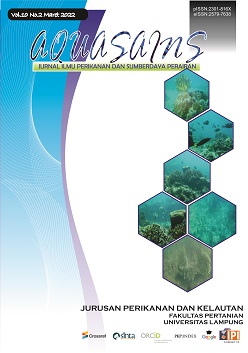DIFFERENCES IN THE VULNERABILITY OF MEDAKA FISH (Oryzias celebensisis) MALE AND FEMALE TO CLORPYRIPHOS INSETICIDE
DOI:
https://doi.org/10.23960/aqs.v10i2.p1115-1124 Abstract View: 199
Abstract View: 199
Abstract
Chlorpyrifos is one of the most widely used organophosphate insecticides used to control pests on plants. The use of insecticides will produce residues in the soil and on plants and can be carried by rain flows to water bodies. This can pollute aquatic ecosystems and could negatively affected the growth of aquatic biota like Oryzias celebensis. This study aimed to determine the susceptibility of male and female medaka celebes (Oryzias celebensis) to chlorpyrifos insecticide. In this study, five fish medaka celebes were put in each jar in one jar for male medaka fish and female medaka fish with five replications. The parameters measured were survival rate, oxygen consumption rate between male and female of O. celebensis, temperature and pH. Statistically the survival rate of male and female medaka fish showed no statistically significant difference (P>0.05). Likewise, there was no difference between the oxygen consumption levels of male and female medaka fish before and after exposure to chlorpyrifos insecticide (P>0.05). This study concluded that there was no difference in susceptibility to chlorpyrifos insecticides between male and female medaka fish.Downloads
Download data is not yet available.
Downloads
Published
2022-03-21
How to Cite
Sulfitratullah, S., Yaqin, K., & Rukminasari, N. (2022). DIFFERENCES IN THE VULNERABILITY OF MEDAKA FISH (Oryzias celebensisis) MALE AND FEMALE TO CLORPYRIPHOS INSETICIDE. AQUASAINS, 10(2), 1115–1124. https://doi.org/10.23960/aqs.v10i2.p1115-1124
Issue
Section
Articles
License
License for Authors
Authors who publish with this journal agree to the following terms:
- Authors retain copyright and grant the journal right of first publication with the work simultaneously licensed under a Creative Commons Attribution License that allows others to share the work with an acknowledgement of the work's authorship and initial publication in this journal.
- Authors are able to enter into separate, additional contractual arrangements for the non-exclusive distribution of the journal's published version of the work (e.g., post it to an institutional repository or publish it in a book), with an acknowledgement of its initial publication in this journal.
- When the article is accepted for publication, its copyright is transferred to Aquasains Journal. The copyright transfer convers the exclusive right to reproduce and distribute the article, including offprint, translation, photographic reproduction, microfilm, electronic material, (offline or online) or any other reproduction of similar nature.
- Authors are permitted and encouraged to post their work online (e.g., in institutional repositories or on their website) prior to and during the submission process, as it can lead to productive exchanges, as well as earlier and greater citation of published work (See The Effect of Open Access).
- The Author warrant that this article is original and that the author has full power to publish. The author sign for and accepts responsibility for releasing this material on behalf os any and all-author. If the article based on or part os student’s thesis, the student needs to sign as his/her agreement that his/her works is going published.
License for Regular Users
Other regular users who want to cite, distribute, remix, tweak, and build upon author’s works, even for commercial purposes, should acknowledge the work’s authorship and initial publication in this journal, licensed under a Creative Commons Attribution License.
This license lets others distribute, remix, tweak, and build upon your work, even commercially, as long as they credit you for the original creation.
This work is licensed under a Creative Commons Attribution 4.0 International License.Copyright Transfer Statement can be downloaded here


.png)









